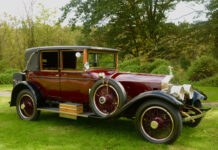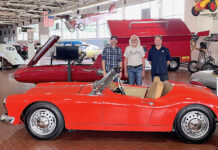By Jay Hirsch
In the early 1950s the German economy and its auto industry in particular were still recovering from the devastation of WW II. The entire country needed to be rebuilt. Mercedes-Benz had its back to the ropes and was in need of a car that would highlight its pre-war racing heritage and the performance associated with it. Financially the company was not in a position to update their warmed-over, late-1930s lineup.
A corporate decision was made in 1950 to get back into the European race circuit, the result of which was the Mercedes-Benz 300SL, Super Leicht, known as body style W194 in racing form. This would be Mercedes’ first production sports car since the 1930s. The 300SL’s origins began in 1952 when Mercedes entered the LeMans with three coupes. The car utilized the production 300 in-line 6 cylinder engine of 2966 cc.
The cars were an instant success, not only on the track but also with the automotive public. This was not lost on Max Hoffman, who at the time was the official importer of Daimler-Benz in the United States. Mr. Hoffman suggested to Mercedes in Stuttgart that a street version of the 300SL would be a success especially in the U.S. The people at Mercedes realized they had something, and in 1954 production began on a road version for the public. The Mercedes Gullwing made its world premiere at the New York Auto show in 1954 in deference to Mr. Hoffmans’s initial suggestion to make a commercial version of the car.
With its advanced tubular space frame, top speed of 160 mph, fuel injection and those Gullwing doors this was just the car to get people into Mercedes showrooms.
At a price of $7,400, sales were not expected to be off the charts, but that was not the goal. The goal was to make the automobile public aware of Mercedes and create interest in their entire line of staid, warmed-over 1930s models.
Eighty per cent of the 1,400 Gullwings made in 1955 and 1956 were sold in the United States. This was the first time Mercedes ever sold more cars of one model outside of Germany, giving validation to Max Hoffman’s suggestion.
The Gullwing was not without its problems though, one being the price and the other those Gullwing doors. While those winged doors created the visual sensation for the car, they were not practical for an everyday or even a weekend driver. Even in 1955 too many people bought a 300SL as a daily driver. The Gullwing doors were built for the racetrack in reality. Ventilation was poor, the hinged windows on the doors just popped out a few inches, the doorsill was high and made entering and exiting the car awkward and tedious. The car was built as a racecar, and what made it tight, taut and relatively aerodynamic with those Gullwing doors, in addition to photogenic, did not enhance it as weekend driver.
These inherited quirks that were built into the Gullwings as a track car remained when the car hit the consumer market in 1955, three short years after its debut at LeMans. A steering wheel with a tilt-away column was added to improve driver access. This made entry and exit only slightly less acrobatic.
Shortly after its arrival on the consumer market it was back to the drawing board at Mercedes, and in 1957 a 300SL roadster made its debut at the Geneva Auto Show. The roadster had standard style doors with glass windows that rolled down into the door. It also had a reasonably-sized trunk, something the Gull did not have. The cockpit had improved space and more comfortable seats.
There was an optional hardtop in two versions. One was the standard lift off hardtop that was similar to that on the Corvette and 1955-1957 Thunderbird. This hardtop was $178 in 1957.
There was also a prototype Gullwing hardtop as seen in the photos here. The roof had two hinged panels that one could push up to make entry and exit more accommodating. It also went with the Gullwing look. You had the look of the Gullwing and the improved ventilation and versatility of the roadster. Whether due to the initial cost of the Gull hardtop or the lack of interest by consumers only a few prototypes of these hardtops were made. The optional hardtops that were produced for the public were the conventional one-piece, lift-off top.
There were 1,400 Gullwing Coupes made and 1858 roadsters. The Gullwing coupe was produced from 1954-1957. The roadster from 1957-1963. The original 300SL racecar was made 1952-1953, body style W 194.
Depending on rear axle ratio on the production cars the 300SL had a top speed of 146 mph or 160 mph,
The 300SL Gullwing’s body was mainly steel, except for the aluminum hood, doors and trunk lid. The Gullwing could also be ordered with an all-aluminum outer skin at tremendous added cost, and saving 176 pounds in weight. By 1963 the roadster cost $10,000 plus.
Today Gullwing models can cost $750,000 and up depending on the wheels on the car, production model number, aluminum body, originality, etc. That “up” can be in the mid-seven figures. The roadster version of the 300SL is not too far behind in value.
The 1956 silver Gullwing seen here has had the same owner since 1964. Aside from a repainting in the early 1970s it is an original car. The interior, chrome and engine are as when delivered new. In 1964 this “used” Gullwing was $4,800. The car is used year round. The winter months being limited to the amount of snowfall and salt on the road.
The 1960 silver roadster has been cosmetically restored, that being a repaint in original color, and the engine being original with low miles. The Fantasy Yellow 1958 Roadster is a factory Mercedes color and is an original car. The 1957 red Gull roadster was repainted in the late 1960s and has had three owners in the course of its automotive life. Until the mid 1990s it was a year-round weekend driver. It now see’s action from April through November.
“Cars are made to drive, and enjoy! If you cannot afford to drive it, don’t own it,” said the current owner. •



